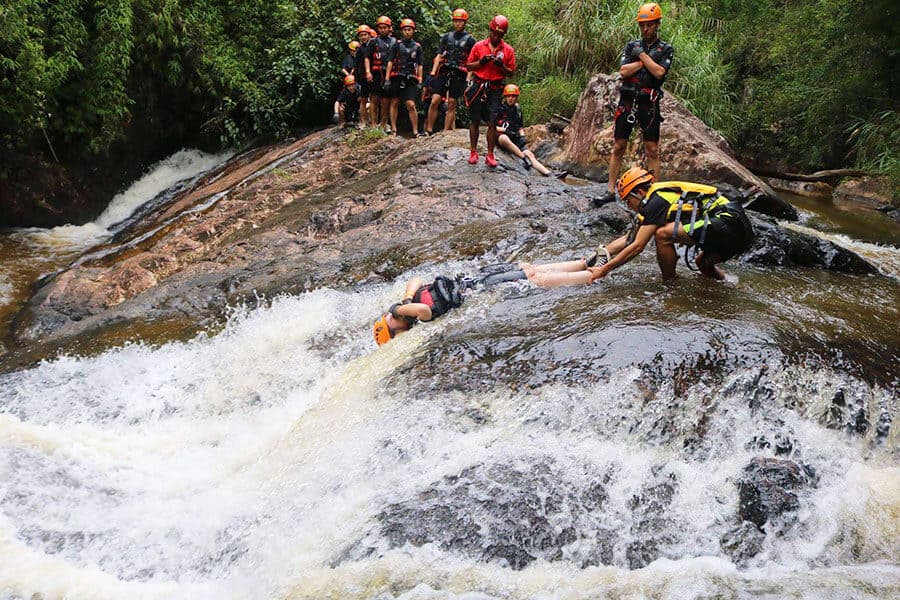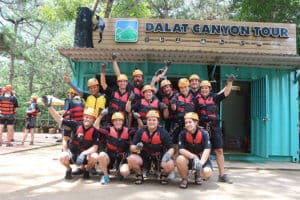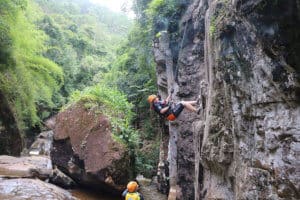Canyoneering is a fun activity that simply means exploring a canyon from point A to point B using a range of techniques. This can include walking, rafting, climbing, sliding, jumping, and more! This type of activity is especially popular in Southeast Asia, and many people travel to gorgeous canyons in that part of the world to take on these adventures. My husband, Isaac, and I discovered canyoneering in China and traveled to Indonesia and Vietnam to experience canyoneering in Southeast Asia first-hand.
Since canyoneering can be done using different techniques, it differs from place to place. The difficulty depends on the natural geography and the chosen route. This can be a very dangerous activity even with all the safety precautions in place. However, tourist guide companies that organize canyoneering tours meticulously scope out the area to see where it’s safe to jump, or if it’s safe to slide, and they attach all the ropes necessary for rappelling. Three of the most popular destinations for this are Da Lat in Vietnam, Cebu in the Philippines, and Denpasay in Bali, Indonesia.
Da Lat, Vietnam
Da Lat is a great city in the south of Vietnam’s Central Highlands. This unique city came visibly under French influence after being discovered by a European in 1893. It became part of Vietnam in 1975 and is a popular international tourist destination today. It is known for its avocados, waterfalls, and as a hotspot for canyoneering!
“Don’t be lazy, be crazy!” was the slogan of Highland Sport Travel, the company that strapped us into harnesses and pushed us (psychologically) off of cliffs. After signing our lives away in scary waivers, we had a quick course in how to descend a cliff safely. While canyoneering can be 100% harness-free, this particular area focuses on rappelling down steep rocks into the canyon!
“Our guide was an awesome guy,” says Isaac, “He was full of jokes while guiding us down the cliffs safely. He told us that Vietnamese men were like chili peppers – small but spicy.”
The entire canyoneering experience involved three cliffs to rappel down, one 10-meter cliff jump, one backwards waterfall slide, and a rainforest hike. The final cliff was the most challenging, where we needed to rappel alongside a waterfall. It’s known as the washing machine, because if a climber makes an error, it causes the climber to spin uncontrollably like wet laundry.
“One moment you are climbing down a cliff,” says Isaac, “The next you are trying not to drown while a waterfall pummels you. It’s impossible to see, hard to breathe, and you forget when you’re supposed to let go of the rope. If you do it too soon, the force of the waterfall dips you deep underwater, causing extra panic until you surface and realize that you have survived!”
Cebu, Philippines
The island of Cebu in the Philippines went from being a hidden gem to a bustling tourist destination almost overnight. On the island there are dozens of breathtaking waterfalls that draw visitors from all over the world. One of the best ways to experience them is to go canyoneering in Kawasan.
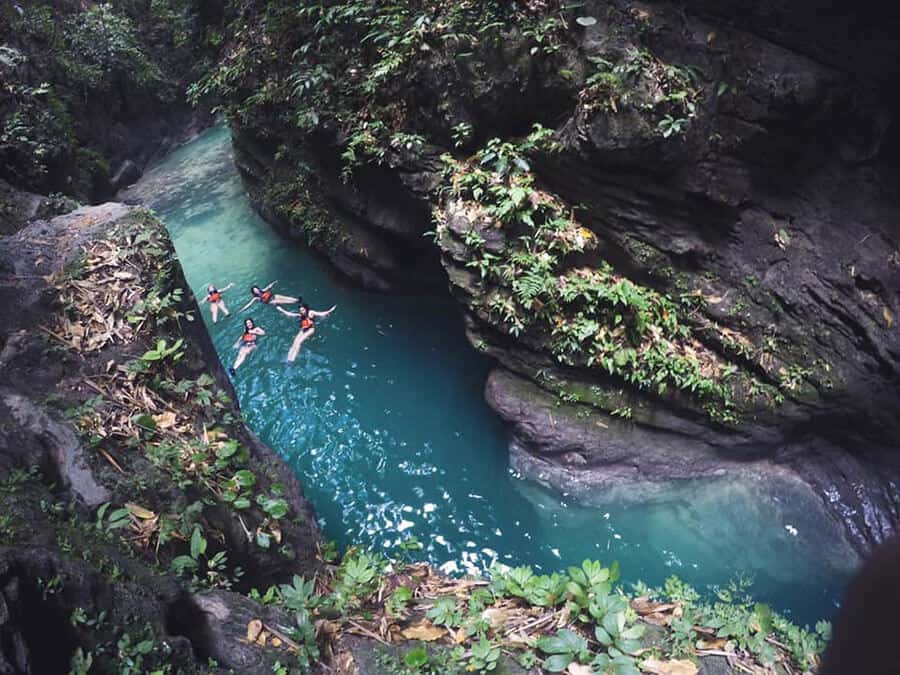
This was on my itinerary during a trip to Cebu with my friend Rosa. Unfortunately, the weather had other ideas, and the rain made it too dangerous to go. Luckily, another friend of mine got to experience it another time and told me all about it. Ella, a 34-year-old adventurer from the UK, was lucky enough to go on a sunny day and had an absolute blast.
“I loved it because it combines being immersed in absolutely stunning natural scenery with the adrenaline rush of jumping off waterfalls,” Ella says. “I had never met the people I did it with before, either, and it was such an amazing bonding experience. We all helped and supported each other, and we laughed so much!”
Kawasan Canyoneering is one of the best companies to use to embark on this adventure in Cebu. This area requires a little less reliance on ropes and more jumping than Da Lat in Vietnam. In Kawasan you can experience rappelling, scrambling, rock hopping, water slides, swimming, and cliff jumping. Canyoneering is definitely not for the faint of heart; and once you begin, it is not always possible to turn back.
Bali, Indonesia
While Isaac and I traveled to Bali with high hopes for adventure, we did not plan on discovering the Hidden Canyon. On a regular tour of the beautiful island of Bali, our guide mentioned that this is a great place to explore. Without doing any research, we signed up to do a tour. Nothing could have prepared us for what was about to happen.
“We don’t like to waste money,” Isaac says. “So when we finished the first and easiest canyon of three, the guide asked us if we wanted to continue. Despite the difficulty so far, there was no question. Since it had been rainy, it was more dangerous than usual. But we didn’t want to regret missing out on the rest of the experience.”
The Beji Guwang Hidden Canyon in Bali is very different from both Da Lat and Cebu. There are no ropes, no rappelling, no cliff jumping. The entire two-hour experience involves scrambling along without any sort of harness, helmet, or life vest. This one-of-a-kind canyon offers a unique and extremely challenging canyoneering experience.
“The tour began with walking through the river,” Isaac says. “Just walking against the flow with water up to our knees was quite difficult and it only got harder! Once we got to the canyon opening, we had to climb on the edges, holding on for dear life. We had two guides for both of us, and sometimes both were involved in getting one of us across the canyon, one at a time.”
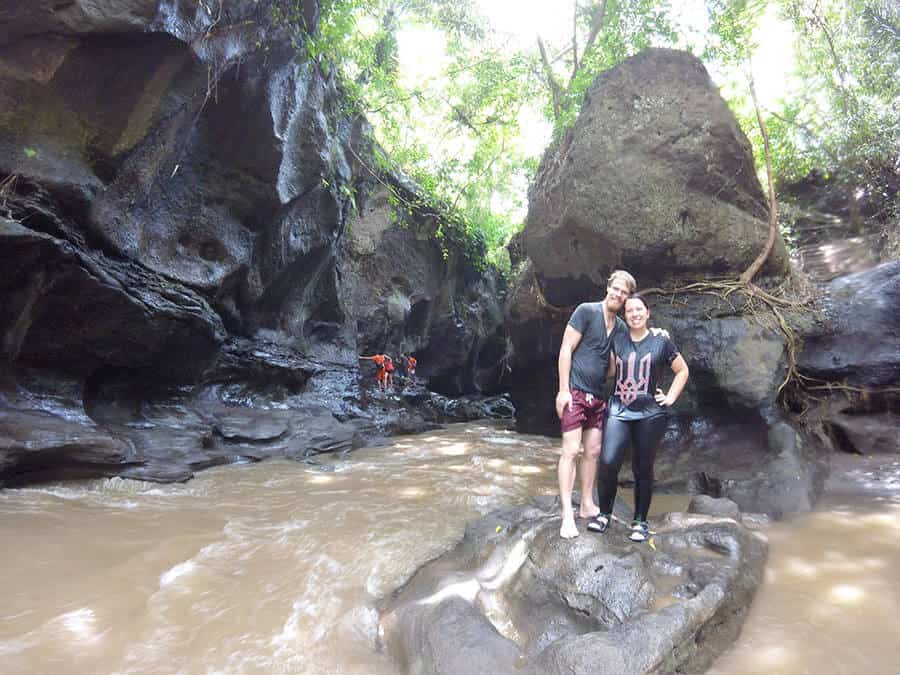
With the recent rain, there was extra water, and the river flowed much faster than usual. There were several points when we had to cross the rushing water to get to the other side of the canyon. Even with ropes and two guides to help us, it was hard and dangerous. At one point I lost my footing and was underwater, with a guide jumping in to grab me to keep me from getting carried away by the current.
“I thought she was going to die,” Isaac says. “It suddenly felt like a terrible idea to do this without any sort of helmet, life vest, or other safety precautions. We didn’t even have travel insurance, not that it would cover extreme sports such as this! While I was freaking out on a safe rock, the two guides got Olena out of the water. Her first question when she was safe was, ‘Did you get that on camera?!’”
Other Adventures around the Globe
Isaac was born in the USA and met me in Prague, Czech Republic. We began our travels in Europe but couldn’t get enough, so we moved to Shanghai, China. From there, we spent two years exploring and adventuring in nearby countries. We hiked through a double typhoon, stood on the world’s longest and highest glass-bottom bridge and went swimming during a tsunami.
Now, after a year of living in New York, we have settled down in Isaac’s home state of Rhode Island. After taking a helicopter tour over Niagara Falls, we hope to explore the world from greater heights, by skydiving in New Hampshire. We built up our taste for adventure travel by canyoneering in Southeast Asia.
Isaac took a road trip from Prague to go swing jumping off a bridge in the middle of the Czech woods. Swing jumping involves jumping off a bridge with the bungee rope tied to the other side, causing you to swing after a 30-meter free-fall.
I spent four months studying abroad on the Big Island in Hawaii. It is home to South Point, the southernmost point of the United States. This spot has a scenic cliff overlooking an endless, vast ocean. It is also a popular spot to cliff-jump. If the 15-meter drop isn’t enough to get your blood pumping, the climb back up definitely will. The three slippery metal ladders are tied together in a way that swings them while you climb back up. Most of the climb is at an incline that may lead into a second, unexpected fall back into the water.
Future Bucket List Adventures
Isaac and I have a lot more adventures planned. Our biggest goal is simply to explore more of the world, including taking a cruise to Antarctica. Once you get a taste of adrenaline, it’s difficult not to crave more. High ropes courses, sky diving, and helicopter tours are on the itinerary in our near future.
“We only live once,” Isaac says, “There is so much to do and experience in the world! Rappelling off of cliffs and jumping off waterfalls really makes you feel alive. It is obviously not the only way to enjoy life and is not for everyone. Travel, however, is one of the best ways to discover the true extent of the wonders of the world. It is also a great way to learn more about yourself.”
Photos: From the archive of Olena Kagui
Read more on adventure tourism from the author.
Support us!
All your donations will be used to pay the magazine’s journalists and to support the ongoing costs of maintaining the site.
Share this post
Interested in co-operating with us?
We are open to co-operation from writers and businesses alike. You can reach us on our email at [email protected]/[email protected] and we will get back to you as quick as we can.
